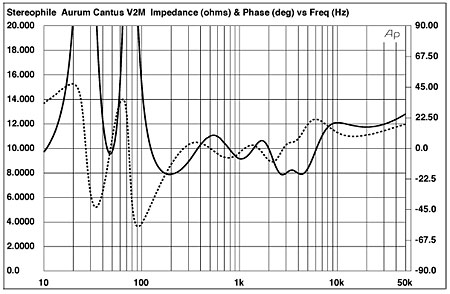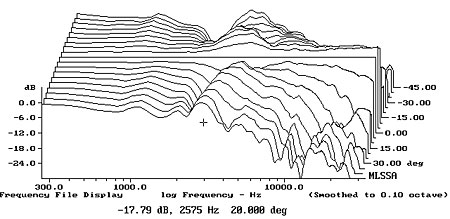| Columns Retired Columns & Blogs |
Aurum Cantus V2M loudspeaker Measurements
Sidebar 3: Measurements
The Aurum Cantus V2M's voltage sensitivity came in at an estimated 84dB(B)/2.83V/m, significantly lower than both average and specified. Alleviating the speaker's needs for volts, however, is the fact that its impedance magnitude remains above 8 ohms at almost all frequencies, and that the electrical phase angle is generally low (fig.1). Though the impedance traces are free from the discontinuities that would suggest the presence of cabinet resonances, investigating the panels' vibrational behavior with a plastic-tape accelerometer did uncover some modes (fig.2). These are high enough in frequency that they will probably not muddy the speaker's reproduction of the midrange.

Fig.1 Aurum Cantus V2M, electrical impedance (solid) and phase (dashed). (2 ohms/vertical div.)

Fig.2 Aurum Cantus V2M, cumulative spectral-decay plot calculated from output of accelerometer fastened to center of side panel (MLS driving voltage to speaker, 7.55V; measurement bandwidth, 2kHz).
The saddle at 48Hz between the twin bass humps in the impedance-magnitude trace suggests that this is the tuning frequency of the reflex-loaded woofer, and indeed, the woofer's response, measured in the nearfield (fig.3, blue trace), has the expected minimum-motion notch at that frequency. The port's output (fig.3, red trace) peaks between 35 and 70Hz and has a well-controlled rolloff above that region—at least until the upper midrange, when a sharp spike appears at 910Hz, this due to a pipe resonance of some kind. Fortunately, the port faces to the rear of the speaker, which will reduce the audibility of this mode. The black trace below 300Hz in fig.3 shows the complex sum of the nearfield woofer and port responses, taking into account both acoustic phase and the different distance of each radiator from a nominal farfield microphone position. There is only a faint trace of the expected nearfield boost in the upper bass, suggesting that the V2M's reflex alignment is somewhat overdamped. As Bob Reina describes in his auditioning comments, this gives an optimal balance of midbass weight and low-frequency definition.

Fig.3 Aurum Cantus V2M, anechoic response without grille on tweeter axis at 50", averaged across 30° horizontal window and corrected for microphone response, with nearfield responses of woofer (blue) and port (red), plotted in the ratios of the square roots of their radiating areas below 300Hz and 1kHz, respectively, with complex sum of woofer and port responses plotted below 300Hz (black).
Higher in frequency in fig.3, the black trace shows the farfield response, averaged across a 30° horizontal window on the tweeter axis. It is basically very flat, but with the mean level in the tweeter region 2dB or so hotter than that in the upper midrange. In addition, a broad, shallow suckout is evident between 3 and 6kHz. I at first thought this was due to a suboptimal crossover topology, but as the crossover point is set somewhat lower, at just above 2.5kHz, it must result from something else. However, this suckout does contribute to the V2M's low measured sensitivity. Interestingly, the Aurum's plot of lateral dispersion (fig.4) suggests that this suckout fills in somewhat to the speaker's sides, which is probably why BJR was not bothered by the speaker sounding too polite or laid-back. This behavior also explains why he didn't find the tweeter to sound disconnected from the speaker's lower-frequency presentation. However, the ribbon tweeter does offer reasonably wide dispersion in its top two octaves, which, in combination with its rather "hot" level on-axis, will correlate with Bob's feeling that the V2M's treble was "airy" and "sparkling" compared with that of speakers with conventional dome tweeters.

Fig.4 Aurum Cantus V2M, lateral response family at 50", normalized to response on tweeter axis, from back to front: differences in response 90–5° off axis, reference response, differences in response 5–90° off axis.
In the vertical plane (fig.5), a large suckout develops at the crossover frequency almost immediately below the tweeter axis, which fills in for listening axes 5–15° above that axis. Short stands will work better than tall ones with the V2M, though the ribbon's very restricted vertical dispersion will give a somewhat airless balance if the listener sits more than 10° above the tweeter axis.

Fig.5 Aurum Cantus V2M, vertical response family at 50", normalized to response on tweeter axis, from back to front: differences in response 45–5° above axis, reference response, differences in response 5–45° below axis.
Turning to the time domain, the V2M's step response on the tweeter axis (fig.6) reveals that both the tweeter and woofer are connected in positive acoustic polarity, and that the decay of the ribbon's step is nicely integrated with the leading edge of the woofer's step. This confirms the optimal crossover topology, which is why I conjectured that some other factor must be responsible for the octave-wide depression in the mid-treble region of the tweeter-axis response. The Aurum's cumulative spectral-decay plot on the tweeter axis (fig.7) is superbly clean, which will go some way toward explaining BJR's very positive feelings about the speaker's clarity and resolution of detail.

Fig.6 Aurum Cantus V2M, step response on tweeter axis at 50" (5ms time window, 30kHz bandwidth).

Fig.7 Aurum Cantus V2M, cumulative spectral-decay plot on tweeter axis at 50" (0.15ms risetime).
I was impressed by the Aurum Cantus V2M's measured behavior. There is already plenty of competition in the high-performance, $2000/pair bookshelf market, with models from AAD, Monitor Audio, and Harbeth taking the lead. Even so, the V2M is a worthy contender.—John Atkinson
- Log in or register to post comments




































